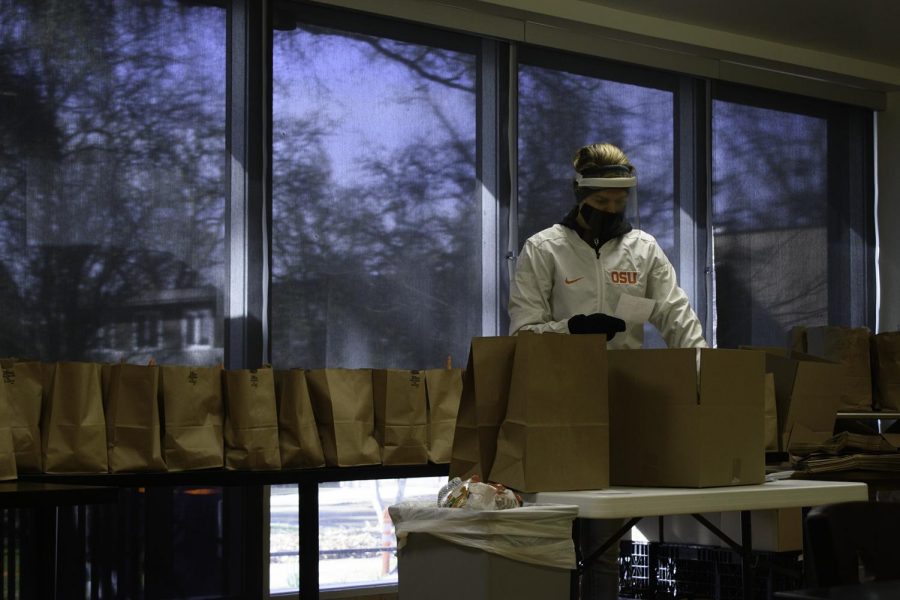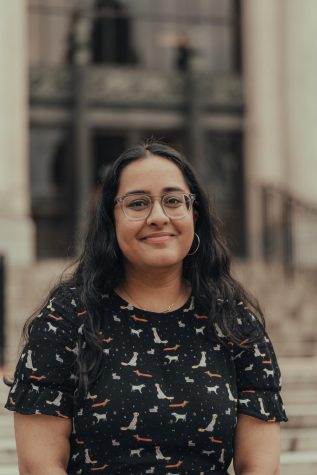OSU research shows increase in food insecurity during pandemic; HSRC urges students to apply for SNAP
March 29, 2021
Two Oregon State University professors are conducting the first campus-wide assessment of food insecurity, and expect their research findings to highlight the rate of OSU students experiencing food insecurity during the pandemic.
Jenny Jackson, clinical assistant professor of nutrition, and Mark Edwards, professor of sociology at OSU leads the research team, which includes undergraduate and graduate students from the College of Public Health and Human Sciences and the College of Liberal Arts.
According to the United States Department of Agriculture’s Economic Research Service, food insecurity is defined as “limited or uncertain availability of nutritionally adequate or safe foods, or limited or uncertain ability to acquire acceptable foods in socially acceptable ways.”
Jackson and Edwards explained that food insecurity presents serious consequences that impact the health, well-being and academic achievement of college students.
Their assessment includes students based in the Corvallis and Bend campuses, as well as Ecampus students. Their survey of the Corvallis campus was conducted during fall 2020. Surveys of the Bend campus and Ecampus were underway during winter 2021.
Before the COVID-19 pandemic, Jackson and Edwards said the prevalence of food insecurity in the U.S. had declined from a high of 14.9% in 2011 to 10.5% in 2019.
Similarly, Oregon in particular experienced a decline in food insecurity from a high of 16% between 2013 and 2015 to 11% between 2016 and 2018.
Mark Edwards’ earlier research in December 2020 estimated that the food insecurity rate for Oregon households had more than doubled in 2020 to almost one million Oregonians, or approximately one-in-four households.
“COVID-19 has resulted in higher rates of unemployment and poverty, which in turn lead to increases in food insecurity,” Jackson and Edwards said. “Projections indicate that food insecurity rates are dramatically higher now than they were pre-pandemic.”
Jackson and Edwards said their survey consists of questions from the USDA Food Security Survey Module, as well as social and demographic characteristics known to be associated with food insecurity.
Jackson said all OSU students on multiple campuses were given a chance to participate in the survey. In total, about 3,000 Corvallis campus students have participated.
Initial estimates show that around 25% of those 3,000 students—maybe more—were food insecure during the first half of fall term.
“The rate of food insecurity among college students is higher compared to the general U.S. population; however, previous studies among college students have produced wide-ranging estimates,” Jackson and Edwards said. “An objective of our study is to improve upon sampling methods by using an innovative classroom-based sampling design in addition to the more commonly used email-based sampling design.”
Ultimately, Jackson and Edwards said the intent of their assessment is to inform future interventions aimed at decreasing or eliminating food insecurity among the OSU community.
“We anticipate our findings will reveal that OSU students also experience food insecurity at a higher rate than the general population,” Jackson and Edwards said. “We also expect to find significant differences in the rate of food insecurity depending on whether it was estimated by the classroom-based or the email-based survey.”
However, according to Jackson and Edwards, even administrators for the Oregon Food Bank—while urging everyone to contribute to food drives so emergency food is available to anyone who needs it—suggest that other, more regular forms of support such as the Supplemental Nutrition Assistance Program are more effective for increasing food security.
Aside from offering a now-digital textbook-lending program and free laundry services, the Human Services Resource Center can help students find general resources, financial aid resources, Oregon Health Plan and SNAP assistance through meeting with Basic Needs Navigator Miguel Arellano, or through their website.
Emily Faltesek, registered dietician and food security program coordinator at the HSRC, said SNAP eligibility requirements recently changed to make it easier for college students to qualify for benefits, and recommends all college students check the HSRC website for more information.
“Right now, signing up for SNAP, if you are an undergraduate, domestic student, is a really great way to get around $200 a month to spend on groceries,” Faltesek said.
On Fridays throughout the academic year, the HSRC has the Healthy Beaver Bags program from 12 p.m. to 2:30 p.m. This provides students with a curated bag of groceries with a theme, a featured recipe and nutrition information.
“One thing that we noticed right away during the pandemic was students were saying they needed more access to more groceries and more support,” Faltesek said.
The HSRC designed the Healthy Beaver Bags program to offer more access to healthy food options, and these meal kits can be picked up by OSU students with a valid student ID at the back porch of Champinefu Lodge on the OSU Corvallis campus.
There is also a food pantry every Wednesday from 10 a.m. to 3 p.m at the HSRC. where community members can pick up food, also on the back porch of Champinefu Lodge.
“One thing we hear sometimes is people show up and they’re like ‘oh, this is real food,’” Faltesek said. “And we’re like, ‘yeah, this is real food.’ Today we gave out bananas and romaine and apples and potatoes. We have four different kinds of rice, so you can use the kind you’re used to.”
These two services, Healthy Beaver Bags and the food pantry, allow for OSU students and community members to come in throughout the week for food assistance.
In December 2019, the HSRC had 307 food pick-ups, while in December 2020, there were 726.
“Not every month is that wide,” Faltesek said. “Some other ones to look at would be November of 2019; we had 647 [food-pickups] and then November 2020 we had 1,032. So we are seeing that a lot more folks are coming to pick up food than before, and we’re seeing a lot of interest in cooking; a lot of interest in cooking from home.”
Faltesek said this rising interest in home cooking is likely because many places where college students might get food are not currently accessible, so the HSRC focused on listening and responding to what students need throughout the pandemic.



















































































![Newspaper clipping from February 25, 1970 in the Daily Barometer showing an article written by Bob Allen, past Barometer Editor. This article was written to spotlight both the student body’s lack of participation with student government at the time in conjunction with their class representatives response. [It’s important to note ASOSU was not structured identically to today’s standards, likely having a president on behalf of each class work together as one entity as opposed to one president representing all classes.]](https://dailybaro.orangemedianetwork.com/wp-content/uploads/2025/03/Screenshot-2025-03-12-1.00.42-PM-e1741811160853.png)
























